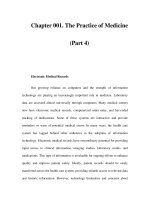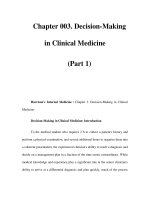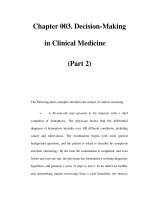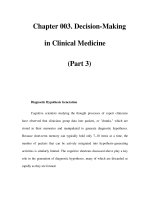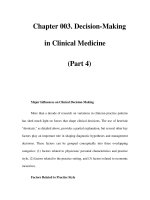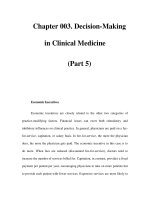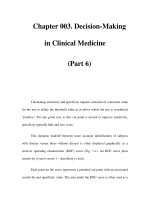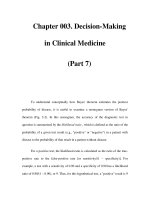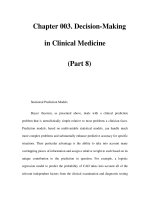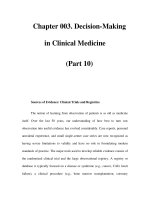Chapter 067. Applications of Stem Cell Biology in Clinical Medicine (Part 4) pot
Bạn đang xem bản rút gọn của tài liệu. Xem và tải ngay bản đầy đủ của tài liệu tại đây (12.93 KB, 5 trang )
Chapter 067. Applications of Stem Cell
Biology in Clinical Medicine
(Part 4)
Other Organ Systems and the Future
The use of stem cells in regenerative medicine has been studied for many
other organ systems and cell types, including skin, eye, cartilage, bone, kidney,
lung, endometrium, vascular endothelium, smooth muscle, striated muscle, and
others. In fact, the potential for stem cell regeneration of damaged organs and
tissues is virtually limitless. However, numerous obstacles must be overcome
before stem cell therapies can become a widespread clinical reality. Only HSCs
have been adequately characterized by surface markers to allow unambiguous
identification, a prerequisite for reliable clinical applications. The pathways for
differentiating stem cells into specific cellular phenotypes are still unknown, the
migration of transplanted cells is uncontrolled, and the response of the cells to the
environment of diseased organs is unpredictable. Future strategies may employ the
coadministration of scaffolding, artificial extracellular matrix, and/or growth
factors to orchestrate differentiation of stem cells and their organization into
appropriate constituents of the organ. Imaging techniques are needed to visualize
stem cells in vivo after transplantation into humans. Fortunately, stem cells can be
engineered before transplantation to contain contrast agents that may make this
feasible. The potential for tumor formation and the problems associated with
immune rejection are significant impediments. Many strategies for cell
replacement already include vasoactive endothelial growth factor (VEGF)
coadministration to foster vascularization, which is required for survival and
function of the transplant. Some stem cells have been engineered to have an
inducible suicide gene so that the cells can be eradicated in the event of tumor
formation or some other complication. The potential for stem cell therapies to
revolutionize medical care is extraordinary, and disorders such as myocardial
infarction, diabetes, Parkinson's disease and many others are attractive targets.
However, such stem cell–based therapies are at a very early stage of development,
and perfection of techniques for clinical transplantation of predictable, well-
characterized cells will be a difficult and lengthy undertaking.
Ethical Issues
Stem cell therapies raise contentious ethical issues that must be addressed
in parallel with the scientific and medical opportunities. Our society has great
diversity in religious beliefs, concepts of individual rights, tolerance for
uncertainty and risk, and boundaries for how scientific interventions should be
used to alter the outcome of disease. In the United States, the federal government
has authorized research using human ES lines in existence before August 2001 but
has restricted the use of federal funds for developing new human ES lines.
However, these existing lines develop abnormalities with time in culture and are
contaminated with mouse proteins. These findings have sparked renewed debate
about the need to develop new human ES cell lines.
In considering ethical issues associated with the use of stem cells, it is
helpful to draw from experience with other scientific advances, such as organ
transplantation, recombinant DNA technology, implantation of mechanical
devices, neuroscience and cognitive research, in vitro fertilization, and prenatal
genetic testing. From these and other precedents, we learn the importance of
understanding and testing fundamental biology in the laboratory setting and in
animal models before applying new techniques in carefully controlled clinical
trials. When these trials occur, they must include full informed consent and have
careful oversight by external review groups.
Ultimately, medical interventions will be scientifically feasible but ethically
or socially unacceptable to some members of a society. Stem cell research raises
questions about the definition of human life, and it has raised deep fears about our
ability to balance issues of justice and safety with the needs of critically ill
patients. Health care providers and experts with backgrounds in ethics, law, and
sociology must help guard against the premature or inappropriate application stem
cell therapies, and the inappropriate use of vulnerable population groups. On the
other hand, these therapies offer important new strategies for the treatment of
otherwise irreversible disorders. An open dialogue between the scientific
community, physicians, patients, and their advocates, lawmakers, and the lay
population is important to raise and address ethical issues and to balance the
benefits and risks associated with stem cell transfer.
Acknowledgments
The author acknowledges the contributions of David Bodine, J. Larry
Jameson, and Ron McKay to this chapter in the 16th edition
Further Readings
Committee on the Biological and Biomedical Applications of Stem Cell
Research
et al: Stem Cells and the Future of Regenerative Medicine. Washington,
D.C., National Academies Press, 2002
Holland S et al: The Human Embryonic Stem Cell Debate: Science, Ethi
cs
and Public Policy. Cambridge, MA, MIT Press, 2001
Lanza R
et al (eds): Essentials of Stem Cell Biology. San Diego, Elsevier
Academic Press, 2006
Mimeault M et al: Stem cells: A revolution in therapeutics-
recent advances
in stem cell biology and thei
r therapeutic applications in regenerative medicine
and cancer therapies. Clin Pharmacol Ther 82(3):252, 2007 [PMID: 17671448]
National Institutes of Health: Stem cell information page. URL:
Puceat M, Ballis A: Embryonic stem cells: From bench to bedside. Clin
Pharmacol Ther 82(3):337, 2007 [PMID: 17637781]
Sugarman J: Ethics and stem cell therapeutics for cardi
ovascular disease.
Prog Cardiovasc Dis 50(1):1, 2007 [PMID: 17631433]
Vats A et al: Stem cells. Lancet 366:592, 2005 [PMID: 16099296]
